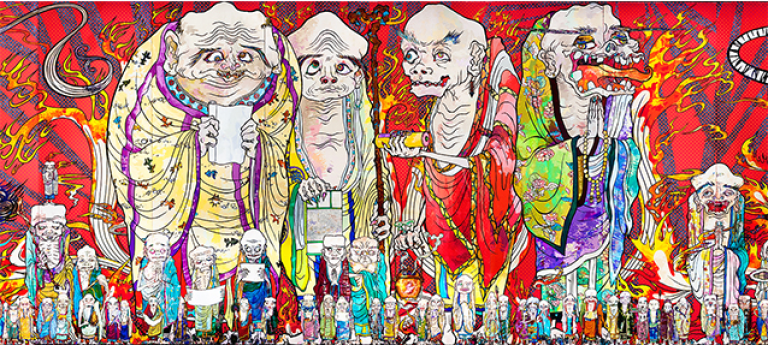Takashi Murakami is a contemporary Japanese artist born in Tokyo in 1962. He studied Japanese painting at the Tokyo National University of Fine Arts and Music where he earned a bachelor’s degree in fine arts in 1986 and went on to earn his Ph.D. in 1993 (Naka). Murakami was trained in the traditional Japanese art of Nihonga, a nineteenth-century style of Japanese painting that combines Japanese and European painting techniques, while obtaining his bachelor’s degree.

However, he soon became fascinated by the manga and anime styles that are popularized in cartoons and comic books, because these themes are more relevant in Japanese society today. Murakami’s turn to a more commercially relevant pop art style while including the Japanese obsession with anime called ‘otaku’ resulted in a mix between the two words called “poku” (“Takashi Murakami Biography.”) In the late 1990s Murakami developed a character called Mr. DOB, a cartoon that is a mix between Micky Mouse and a popular Japanese character Doraemon. Mr. DOB’s name stems from the Japanese word ‘dobojite,’ which means ‘why’ and was originally created with the idea that Japanese art/artists don’t need to imitate Western art/artists and should find it’s own unique style (Goldstein). Though the appearance of Mr. DOB changes frequently to reflect different aspects of Murakami’s personality, his presence is still noted in his most current works.

Because of the unusual nature of Murakami’s art, many were hesitant to refer to it as fine art. Some critics said that while pleasing to the eye his work carried no substance (“Takashi Murakami Biography”). His unusual style brought much attention from art circles in Japan and the United States. With this newfound popularity came another burst of success due to his collaboration with fashion designer Louis Vuitton. The purses that he designed became the new “hot” item to have in the early 2000s and helped him to gain much recognition, but unfortunately as a designer instead of as an artist. In order to reestablish connections with his art Murakami decided to take time away from commercial art to focus on his fine art style.

In the early 2000s Murakami began producing his paintings in what he calls factories, where his sketches are digitally scanned and printed onto paper, which is then silk-screened onto canvas and painted (“Takashi Murakami Biography”). This technique produces little depth or perspective so Murakami named the technique “Superflat” a unique mix between two dimensional forms and bright imagery (Naka). The term “Superflat” also references computer screens and flat screen televisions and seeks to blur the line between fine and commercial art. Today Murakami continues to produce works in his unique “Superflat” style with the addition of new characters to his work over the years like the KaiKai KiKi, mushrooms, and most recently the Daruma, Buddhist monks who are based off the patriarch of Zen Buddhism who supposedly mediated until his limbs fell off.


Sources
Churchill, Maude. “7 Best Louis Vuitton x Takashi Murakami Collaborations.” Highsnobiety. July 17, 2015. Accessed September 02, 2017. https://www.highsnobiety.com/2015/07/17/louis-vuitton-murakami-pieces/.
Goldstein, Andrew M. “The Psychedelic World of Takashi Murakami.” Artspace. March 21, 2013. Accessed September 20, 2017. http://www.artspace.com/magazine/interviews_features/close_look/the_psychedelic_world_of_takashi_murakami-5204.
Mr.DOB And then Rainbow by Takashi Murakami on artnet Auctions, http://www.artnet.com/auctions/artists/takashi-murakami/mrdob-and-then-rainbow. Accessed 2 Sept. 2017.
Mr.DOB And then Rainbow by Takashi Murakami on artnet Auctions, http://www.artnet.com/auctions/artists/takashi-murakami/mrdob-and-then-rainbow. Accessed 2 Sept. 2017.
Naka, Kimiyo. “Takashi Murakami.” Encyclopædia Britannica. May 01, 2016. Accessed September 20, 2017. https://www.britannica.com/biography/Murakami-Takashi.
“Takashi Murakami Biography.” Encyclopedia of World Biography. Accessed September 20, 2017. http://www.notablebiographies.com/news/Li-Ou/Murakami-Takashi.html.
“Who is Takashi Murakami?” http://www.loughrangallery.co.uk/. April 1, 2014. Accessed September 20, 2017. http://www.loughrangallery.co.uk/blog/2014/4/1/who-is-takashi-murakami.aspx.

I like that Takashi Murakami appears to have a wide variety of artistic styles and talents. While the first of his pieces shown is more traditional, the later pieces are colorful and modern. I was surprised to learn that he worked in collaboration with Louis Vuitton to create such a well-known style. This emphasizes that his works are highly veritable. Of the pieces shown, the final one, titled “The 500 Arhats,” is my favorite because of its grotesque stylization.
-Amanda Sulz
LikeLike
I really liked how he started off with a more traditional painting style that combined Japanese and European techniques, It really shows how versatile he is. As time went on and he started working with other aspects, like the anime and manga styles and even basing characters off of our own, western ones, you could tell that this was a man of many talents who didn’t need to stay in one particular subject to become well known. His styles ranges so far and seeing that it got attention from a famous designer is not at all surprising, even if he did go back to working with his fine arts to reconnect with himself, he will now forever be known.
LikeLike
I truly enjoyed learning about how Murakami likes to “blur the line,” as you say, between commercial and fine art. It was very interesting to learn that there is an artist that tries to tackle that division of the arts. I, too, am a fan of both traditional art (although more Western) and anime/cartoonish art. So I can relate to how Murakami keeps his options open between the two.
I agree with Amanda and her comment, when she said she likes the piece titled “The 500 Arhats”. The stylization of the figures and how he was able to keep that consistent throughout the whole piece is very interesting to me. “Arhat” seemed like an interesting word to me so I Googled it. It is a term from Buddhism meaning: someone who achieved the goal of religious life. Once I found out the meaning then I thought it was interesting how, if Murakami was drawing them based off that definition, they do not appear to be the goal of religious life for me. I imagine beauty.
-HUGH KEENE
LikeLike